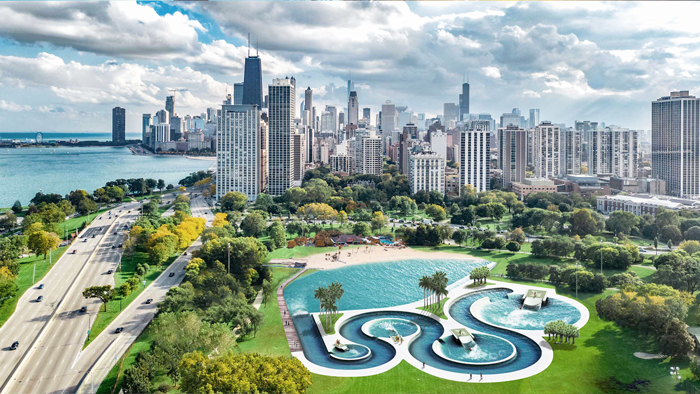It’s not hard to go back in your mind and remember the anticipation and excitement of the local outdoor pool opening for the season, which in the Midwest was typically on Memorial Day weekend. We’d get there plenty early and get in line, as it was always the goal to have the distinction of being the first one to jump in the pool that year. And I have no doubt that kids—and adults too—still experience that feeling of excitement on opening day.
And while my once simple childhood pool is still in operation, it has received some facelifts and upgrades over the decades, adding waterslides, deck seating and shade, an activity pool, a sand play area and enhanced concessions, not to mention extensive programming, party hosting and rental opportunities. This is the evolution of the outdoor aquatic facility, continually morphing to keep up with community desires, bolder attractions, new technologies and innovative programming trends.
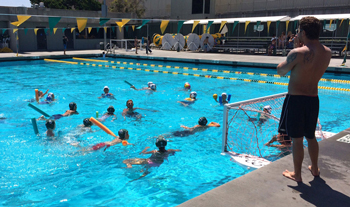
“Often outdoor pools serve various uses, including open recreational swimming for adults and children, swim team and dive team practice and meets, fitness classes, water walking and lap swimming, to name a few,” said Lauren Ozburn, aquatics consultant and project manager at Waters Edge Aquatic Design. She pointed out that lap lanes can take up a significant amount of space and budget, so understanding the practical need for them initially can help establish the foundation for the facility design. “From there, you can start to plan out the rest of the facility based on goals and uses, maximizing the space and budget for shallow water spaces and features. If we don’t need six lap lanes and the community can utilize four effectively, then we in essence can reallocate the space and budget of those two lanes to other uses.”
“Facility owners and operators are always seeking to incorporate as many programming options into their facility designs as possible,” said David Keim, director, public market business development at Aquatic Development Group. “From free swim and water play to training, competition, fitness and learn-to-swim, it seems that the more programming options the better. In recent years, additional programming options may be offered by including pool-based, Ninja-style obstacle courses and in-water, inflatable obstacle courses to more traditional pools.”
Jen Gerber is vice president, strategic partnerships and operations, at Water Technology Inc., an aquatic planning, design and engineering firm, and when starting a new project, they initially help determine a client’s goals and objectives, which she said are “identified early and should be revisited frequently with every proposed design direction. Generally speaking, most communities are looking to maximize user participation and to offset operational expenses.”
Gerber explained that when they get engaged on a project, they build a relationship with the community representatives involved in the project’s planning effort, a relationship that is integral to helping them build trust and work together to identify priorities. “Consultant teams work closely with community planning groups for years during the design and construction of a new or renovated facility. It is imperative that this relationship has that strong foundation to share ideas and address challenges.”
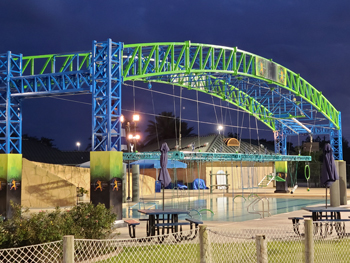
Featuring multiple bodies of water within the same facility—with different water temperatures, depths and features to accommodate varied programming—has been a trend within the indoor facility realm, but it’s also a design strategy being utilized outdoors. “Offering multiple bodies of water is of interest for many communities,” said Ozburn. “Often this is because of the flexibility of offering multiple programs at the same time within the facility, and because of the reduced chance of having to close the whole facility for an event or unplanned maintenance issue.”
The goal of including multiple bodies of water featuring a variety of experiences is “… to deliver flexible and dynamic experiences for people of any age or ability,” explained Justin Caron, principal and CEO of Aquatic Design Group. “Different bodies of water allow for different temperatures and depths delivering the same level of user comfort tailored to the exertion of the activity. For instance, instructional and teaching pools will have warmer temperatures, typically somewhere between 86 and 90 degrees, and shallower water, typically with depths ranging from 2 feet 6 inches to 4
feet 6 inches. Some will also include
a deeper section for low-intensity deep water exercise. Recreation and aquatainment pools will feature varying depths from beach entry to as deep as 13 feet depending on the activity and features. The pools will also commonly include moving water such as a vortex, river current, or wave action. Typical temperatures for these higher intensity spaces are usually in the 84-to-88-degree range.
Offering different bodies of water can also help create different spaces for different users, according to Ozburn, creating “pockets” or “pods” for various groups or individuals. “For example, adults and seniors may spend their time in one area where it is more quiet and they can either sunbathe or have unobstructed use of water space where they can walk, swim or just relax. Teenagers will prefer a space where they can hang out together and get in and out of the pool regularly and with ease, but without disrupting young children and adults.”
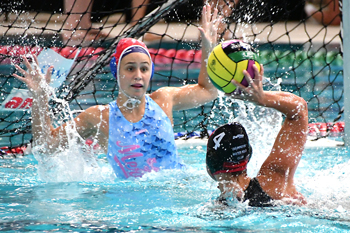
She pointed out that children and toddlers will need shallower water, with quick access to seating, restrooms and concessions, and this space may be loud with an abundance of activity. “Each of these groups will have natural preferences and annoyances, and attention to where and how they can use the facility can assist in creating an environment suited for each.”
Keim said that budgets may not always allow for separate water spaces, but he pointed out that there are other strategies for making outdoor pools multi-use. “Multiple bodies of water allow for a variety of programs to be simultaneously conducted in a facility. Likewise, to reduce overall construction costs, moveable floors and bulkheads may be included in the design of a single pool to provide separate spaces for variable programming. This is becoming an increasingly important consideration with the ever-escalating costs of construction.”
The city of Selah, Wash., was looking to replace an existing 70-year-old outdoor pool with a “more robust aquatic complex.” Though initially envisioned as a three-pool facility, Gerber’s firm worked with city planners to create a single-pool design, reducing construction costs while maintaining play value and space for programming options. Now, the single body of water at the Selah Aquatic Center offers activities and amenities for all ages. The nearly 7,000-square-foot leisure pool features a zero-depth-entry tot section complete with geysers and floral-themed spray features. The current channel offers spray features and space for resistance walking or leisurely floating. A flat four-foot-deep exercise space was designed for water aerobics and active adult programming. There’s an eight-lane lap area for lap swimmers and the local swim team to use for practice and meets. Other features include a basketball hoop and underwater seating.
“There are always benefits in having multiple pools with varied depths, temperatures and offerings for the users at any aquatic facility,” said Gerber. “However, this isn’t always feasible because of the varied project constraints like budget, schedule, space and staffing.”
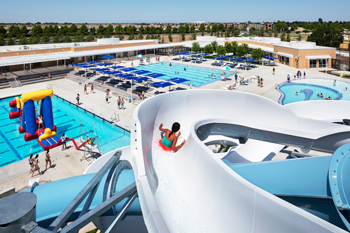
She explained that now more than ever, unprecedented changes within the construction market are forcing designers to respond with creative solutions that will still meet the needs of communities. “With soaring costs, limited construction resource availability and long lead times, we’re seeing many communities examining the benefits of one body of water with multiple features and zones that can accommodate users of all ages and abilities, all at a lower cost.”
Bigger, bolder waterslides and other ride attractions continue to be popular pool features and big draws. And not just in larger waterpark settings; more community outdoor aquatic centers are adding these features to help expand their appeal to a wider demographic and those seeking adventure.
“It seems that bigger is better in outdoor venues to satisfy the entertainment demands of today’s park guests,” said Keim. Possibilities include skill-based adventure rides, including surf rides, tidal rivers and specialty wave pools. Innovative launch portals, wave pool entries and multiple egress and exit ports can maximize throughput, increasing both active and passive capacity. Waves can be quickly and easily adjusted to match a riders’ skill level and choice of board, from boogie board to ocean surfboard. Some facilities offer surf lessons or competitions.
“Over the years we’ve seen significant growth in the demand for more thrilling, commercial waterpark types of amenities in recreation facilities,” said Gerber. “Outdoor aquatic centers have prioritized the desire to feature more large-scale and iconic attractions such as waterslides, surf machines and obstacle courses.” These types of attractions also draw spectators, which can help to increase revenue with things like food and beverage sales.
Gerber described a public swimming pool in Garden City, Kan.—Garden Rapids at the Big Pool—which opened in 2021. It features an action river, a 50-meter competition pool, a splash pad, a zero-entry children’s area and an iconic waterslide complex. It was also the first installation of an impressive standing waterslide, offering the sensation of waterskiing, where riders grab the side rails and glide down on their heels, and an innovative launch slide where riders speed down the slide only to be launched into the air. These two rides were supplied by a Paola, Kan.-based manufacturer of waterslides and waterpark attractions. “These unique installations have created significant attendance regionally, while still serving the needs of the local community,” said Gerber.

Aquatic obstacle and challenge courses continue to gain momentum, showing up at a variety of aquatic facilities. Kyle Rieger is managing partner of an Overland Park, Kan.-based manufacturer of a retractable Ninja-style obstacle course, and in addition to recreation, their systems are also being used for fitness, training, therapy and competition. “Some of our clients have noted pool utilization increasing up to 30%, and others have organized 300-person events on Eventbrite with T-shirts. We’ve shown up with our tradeshow backdrop and interviewed competitors, shooting photos and video. We have even come on site to host/train a staged fitness class with 20 to 30 lifeguards/attendants with our fitness director,” said Rieger.
He mentioned a waterpark customer that’s at capacity most days and has 20 to 30 guests who wait in line to compete on the system, at a facility also featuring waterslide attractions and surf machines. “Because the system requires a skillset to develop, it’s a great mousetrap for operators who desire repeat usage, increased length of stay and a draw for the spectator crowd. The system is patented, so we can enter exclusivity agreements with owners who want to be the first in their market and offer something no one else can,” which Rieger said gives operators an edge on the competition.
The systems can be customized with sound effects and timing systems, and obstacles can be swapped out. Column wraps can be custom-printed for fundraising or advertising, increasing revenue opportunities. There is also a mini system, which “can be installed in less than one day over three or four lane lap pools, activity pools, or to replace a lily pad net climb or water walk,” said Rieger. The system needs no footings and is deck-mounted. And while the larger systems are ceiling-mounted when indoors, when outdoors “we utilize four concrete footings that our arch/superstructure mounts to. The obstacle frame lowers and raises from our steel arch.”
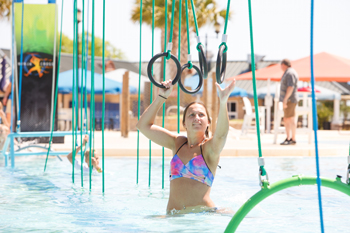
Otter Cove is a wildlife-themed outdoor aquatic park located in St. Charles, Ill., and is operated by the St. Charles Park District. There are four bodies of water, thoughtfully laid out and connected by paths with grassy areas, a splash park, a sand play area, concession house and party pavilions. A giant slide tower holds a body slide, racer slide and drop slide, which empty into the various pools, and a large, winding tube slide that feeds into the lazy river. “We hold swim lessons at the slide shoot-out in the mornings on the lazy river,” said Alex Hartzell, aquatics and youth programs supervisor at the St. Charles Park District. “During our public swim hours, we also offer a ‘Not So Lazy River Walk,’ which allows patrons to get out of their tubes and walk with and against the current for a light exercise. Kids join in too, and it’s a really fun activity to do to change things up!”
An activity pool offers spray features and a frog slide for the little ones, and it’s where the body slide shoots out. “We typically see younger kids in our activity pool because of the zero-depth entry and water depth not exceeding four feet, but we also have a sports court where we get a lot of tweens shooting hoops in the water,” said Hartzell.
Then there’s the lap pool, which offers up a lot of programming opportunities. “Before the pool opens to the public, we offer everything we can in the lap pool; swim lessons, swim team, water polo and lap swim,” explained Hartzell. “Once the pool opens to the public, it offers two diving boards, two drop slides and two lap swim lanes as well as an open swim area.”
And lastly, “the toddler pool is gated, a great feature for adults bringing young kids in.” She added that there are three pump rooms for the four pools and splash park. “It takes quite a while for our maintenance staff to go from room to room testing chemicals every hour.”
When we think of high school and college pools, or other competition venues, most of us picture indoor facilities. But sometimes these pools are situated outdoors as well, and Gerber tells us that the decision to be indoors or outdoors often comes down to a couple key discussions, and not surprisingly, one is total project budget, as natatoriums can come with a larger price tag.

Of course, there’s client preferences to consider, and determining the intended use and user. Also, “Is the pool for recreation purposes or competition and training? Answering these questions during the planning phase is key in identifying a solution for the project.
“Outdoor facilities tend to have increased deck space, (and) it is lower-cost square footage, which is critical to the design of a successful competitive facility,” continued Gerber, bringing up some other points to consider. “Enclosure and canopy technologies are available to offer shade and act as a weather barrier. Temporary, semi-temporary and permanent solutions are all available that can extend the pool season and offer additional operational benefits.”
Additionally, heating and cooling technologies now can make it easier to operate an outdoor venue year-round in certain climates. Gerber also pointed out that, second to staffing, dehumidification costs represent one of the greatest operational expenses for indoor facilities. “In an outdoor environment, 100% of that cost is eliminated. Alternatively, depending on the climate, these outdoor facilities can have a greater demand for pool heating.”
In Cary, N.C., home of the Titans Swimming Team, one of the highest-ranked USA Swimming teams in the country, a 50-meter Olympic-sized outdoor competition pool was recently opened as part of the Triangle Aquatic Center (TAC) campus, and Gerber’s firm was involved in the project. A variety of lane configurations are offered; 20 25-yard lanes and nine 50-meter lanes are available, to be used for programming opportunities such as TAC Titan training, learn-to-swim, certifications, fitness, open swim lanes and community rentals. With advanced heating and cooling technology, training and other programming activities can be held year-round. A canopy was installed over two sides of the pool that acts as a shade structure and a weather barrier to increase operability even further.
With so many amenities, products and programming options available, aquatic facility designers and operators have a lot to consider when planning outdoor pool construction or renovation projects. Therefore, it’s important to engage potential users, to “test the water,” according to Ozburn. “When planning for an aquatic venue that is intended to serve multiple user groups with varying needs, gaining input from various perspectives can be key to developing a plan that will serve the community as intended.” RM



